Question and Answer – May 2009
.jpg)
Question: Can I prune these Texas sage "trees" back to thin them out and make them sturdier? J.A., no city given.
Answer: Any pruning you do should be done with loppers or hand shears, and yes, you could thin them and reduce the height of some of the tallest branches. It would probably be better for the plants if you did a little pruning every few weeks, rather than one major cutting.
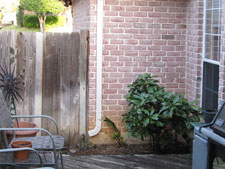
Question: I’m perplexed about what to do with this 4.5-by-8-foot bed. It’s on the north side of our house, so the aucuba is in total shade, but as it grows, its branches stick out into almost full sun and they blacken. There is a functioning gate to the left in this photo, and the windows look out from my home office. What could I plant there that would stay flatter and that would survive the lighting? R.H., Arlington.
Answer: There are as many possibilities as there are landscape designers to offer them. I’ll give you a few ways I might handle it. First, I would remove the existing soil and replace it essentially with a terrific potting soil. Be sure the bed drains well in the process, and take any corrective measures you have to. Then, when space is limited due to pavement or decking, I always rely on large, decorative pots. You could place small river rock or other decorative gravel on the surface of the ground. Let’s assume you chose three decorative pots that looked really good together. You could set the pots on the rock, or, with protection for the wood, you could even let them lap over onto a few inches of your deck to tie things together visually. The pots could accommodate seasonally reliable annual color plants, including tropicals in the summer. You could invest in a quality and decorative wrought iron trellis to put against the fence, then you could put garden art such as smaller moon and sun faces or pot hangers with small potted annuals on it. Use dwarf mondograss as a groundcover through the small river rock. It would tie the plantings all together. There are a thousand other options. Those came to my mind first.
Question: What kind of beetle would attack junipers, plums, willows and pears? Mine are all dying. B.H., Alvarado.
Answer: This won’t be easy. There is no one insect or disease that attacks those four unrelated plants. Willows succumb to cotton root rot and cottonwood borers. Pears suffer from cotton root rot and fire blight. Plums struggle with peach tree borers and bacterial stem canker, and junipers have twig blight and red spider mites. All could have been hurt by drought several years ago and even last year. I do see the holes in the trunks of your juniper. Those appear to be borer holes, but borers aren’t all that common. They may have invaded after the branches were killed by twig blight. I’ve seen a good bit of it in the past 6 or 8 months. In fact, several other questions dealing with it were e-mailed to e-gardens this month alone. You probably ought to have it confirmed through the Plant Disease Diagnostic Lab at Texas A&M. The willow tree trunk looks like it’s been stripped by some type of animal, rodent or otherwise. I’m sorry I can’t get closer with the answer, but you may see some fresh symptoms now that the growing season has begun.
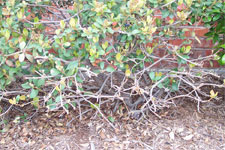
Question: Rabbits have become a nuisance in our yard. What can I do to discourage them? N.P., McKinney.
Answer: No one wants to hurt rabbits in an urban setting, yet they can do a lot of damage. Usually, they prefer bright, fresh grass, so you might consider overseeding a patch (or all) of your lawn with rye in September if you don’t do so already. That would give them something to eat during the winter. Blood meal is a good organic source of nitrogen, and it does seem to offer some deterrent to rabbits. However, my dogs liked to roll in it, so I quit using it in the pansy beds and turned to overseeding instead. You might contact the Heard Natural Science Museum in your city to see if they might offer other suggestions. An online search may turn up some other ideas. You may need to have several tricks to pull into action.
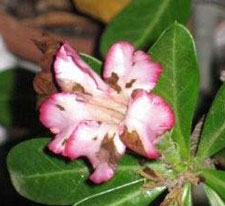
Question: My desert rose flowers have had dead speckles all of the past winter. I suspected thrips, since this looks like their kind of damage, but I can’t find any. Also, Internet searches said that Adeniums are damaged by some systemic insecticides. What might the problem be? S.S., Paris.
Answer: This looks like it could be cold injury, or it could have been precipitated by sunlight hitting the flowers when there were beads of moisture standing on them for a prolonged period during the cooler conditions. Honestly, I do not have a better idea, but I’m hoping there might be a specialist out there who has had this experience and will recognize the symptoms. We’ll watch the "early returns" for you.

Question: Attached is an early-spring photo of our chinquapin oak so that you can see the branch structure. Should it be thinned out? If so, what is the best time of year to do so? D., Plano.
Answer: Your tree looks terrific! I don’t see any immediate need to prune any of it. Watch for competing and rubbing branches, and remove them as needed. That sort of pruning should be done in mid-winter. Spring pruning is especially risky with oaks if you are in an area where oak wilt is active. Your other back-up time for any pruning that may become necessary would be in the hottest part of mid-summer. Seal all cuts, if you ever make any, with pruning paint.
.jpg)
Question: This is what my spiral juniper looked like after the disease caused this damage. A fungicide has stopped its spread, but how can I clean it up, and will the dead spots fill back in? S., no city given.
Answer: Bad news. All of a plant’s new growth is made at the ends of its branches. That’s especially true with cone-bearing plants like junipers. This is the way most spiral junipers end up – either having some type of partial dieback due to bagworms or twig blight, or simply dying due to getting too dry just one time. I wish I could help, but it’s time for a new plant.
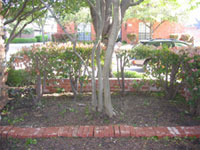
Question: What kind of plant would grow to 3 to 4 feet in shade to replace these redtips? Should I remove the old stumps? Do I need new soil? I’ll be planting holly ferns and dwarf mondograss. D.O., Dallas.
Answer: Dwarf burford hollies will be the most durable shade (or sun) shrubs in that size. Yes, pull the old photinia stumps out before you plant the new shrubs. Once they are out of the way, you can rototill the area and incorporate several inches of organic matter (peat moss, compost, shredded pine bark, rotted manure, etc.) and one inch of expanded shale. Be alerted that you will need to hand-water new plantings through their first summer. Sprinkler irrigation alone will not be sufficient. Be especially careful with new hollies, since they don’t wilt visibly. They can soon get past the point of no return if you’re not careful.
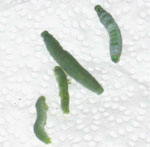
Question: I am seeing the worms shown in my photo chewing holes in the leaves of my collard greens. How can I get rid of them? I’m trying to grow organically, and I’ve used a home-made insecticidal soap. J., no city given.
Answer: These are cabbage loopers, and they will be very damaging to all of the plants in the cabbage family (collards, broccoli, cauliflower, Brussels sprouts and, of course, cabbage). The best control (it is organic) is to dust or spray them with Bacillus thuringiensis ("B.t."). For the record, I’m not a big fan of home remedies, as there are no guidelines, nor are there remedies should things go wrong.
Question: What happened to these hollies on the north side of my house? It was sudden. R.N., no city given.
Answer: Simple. This is freeze damage. They will regrow very quickly. No problem.
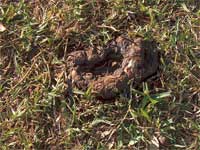
Question: The knees from our bald cypress tree are being kept mowed down by our lawn service. Will they damage the foundation of our house if the tree is 20 feet away? If so, is the only option to cut the tree down? J. and S., Arlington.
Answer: Cypress knees are very strong, so I guess they could do damage. However, you can put some type of durable root barrier in place somewhere between the trunk and the house, preferably closer to the house. The barrier needs to be 24 inches deep, and it needs to run for 25 or 30 feet. A good arborist will know how to help you.
Click here to submit your photo and question.

.jpg)
.jpg)
.jpg)
.jpg)